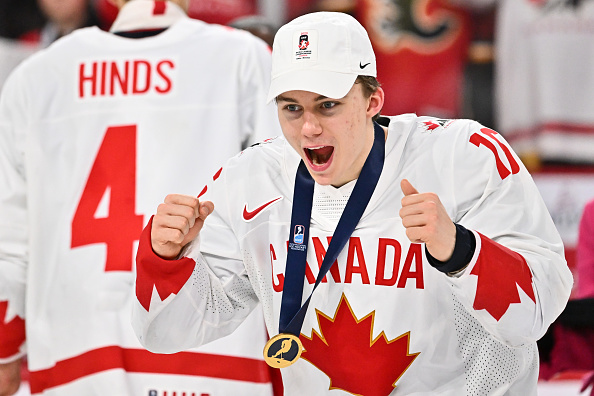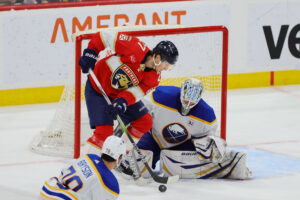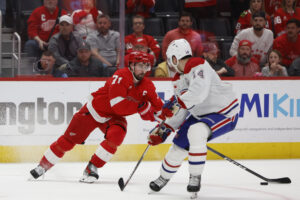The 2023 NHL draft class is a loaded one. From the top with Connor Bedard and Adam Fantilli, it is arguably one of the best classes in recent memory. Add to the fact that there are some intriguing names throughout the projected first round, and it’s clear this draft is also deep. In this piece, we look at one of the best prospects since 2015 Connor McDavid; the dynamic Bedard.
Connor Bedard Scouting Report
Bedard, born in North Vancouver, British Columbia, is a 17-year-old phenom playing for the Regina Pats of the WHL. Standing at 5’10” and 185 pounds, Bedard doesn’t stand out with his physical traits, but it has not held him back in the slightest in juniors.
Over the last three seasons, Bedard has torn apart the WHL. He has scored a combined 209 points in 110 games, including 102 goals. This season, he has 39 goals and 42 assists for 81 points… in 33 games. Every notable site and expert has Bedard ranked first, and no one will take that spot from him, barring something completely unforeseen.
Connor Bedard Deep Dive
Bedard is a generational talent. Yes, that term is thrown around wildly and a bit too often. But McDavid is a generational talent, as are guys like Sidney Crosby and Alex Ovechkin. Bedard is the next guy in line to leave a lasting mark on the hockey landscape. He already has. He’s shattered international records and the dominance he has displayed in the WHL is seldom seen. What makes him such a phenomenal hockey player?
Connor Bedard’s Skating
Bedard is a very good skater, but not quite elite. His agility and fluidity are fantastic, and he skates so effortlessly with or without the puck. He also utilizes his edges very well and can hit top speed very quickly. That acceleration and ability to know when to turn on the jets allow him to catch defenders off, allowing him to beat them. However, his top speed is not elite.
He’s faster than most, and this is by no means a knock on his skating. Bedard beats defenders using his agility, acceleration and insanely high IQ. When it comes to skating, under a microscope, he won’t purely burn defenders with his skating. That’s not a negative, in fact, it shows he knows how to work around it. Once he gets NHL coaching and continues to grow physically, especially in his lower-body strength, he has every trait to develop an elite speed. That’s a scary thought.
Offensive Abilities
Bedard is a threat no matter what he does. Away from the puck? He finds empty space and always presents himself as a passing option for teammates. With the puck? Look at his stats. Passing? He can thread the needle at any point in time, and he has all the confidence, vision and awareness to connect with high-danger passes, consistently. Shooting? His shot is already NHL-ready. He has great shot mechanics, a quick release, a lot of power, and pinpoint accuracy. So to defend him, just pressure him at all times, right? You can certainly try, but he’ll probably collect your ankles in the process. He can stickhandle past anybody, regardless of where he is or who is on him.
Bedard isn’t perfect, of course, but he is as close to being a perfect offensive presence as a 17-year-old could be. There are moments where he can be knocked down a bit too easily, and tries to do a bit too much. For example, he has tried to cut inside of four defenders on several occasions, while driving the net, and handling a bouncing puck. No one can do that, except for maybe McDavid. But there should be no concerns that once he settles into the NHL, he can’t be dominant playing his style.
Shooting Ability
In three tracked games, Bedard fired 32 shots, with 23 hitting the net (including three goals) at even-strength. Of those even-strength shots, 50% came from high-danger. That is an absurdly high clip of shots coming from the high-danger areas of the ice. Adding the power play and penalty kill to those stats, Bedard fired a combined 38 shots, with 29 on net (including five goals). 20 came from high danger (52.63% of his total shots) with 15 hitting the net (51.72% of his shots on net). Five goals in three games in itself are impressive. Being this efficient at getting to high danger consistently is also ridiculous. But for Bedard, it’s the norm. That’s how good he is.
Playmaking Ability
Bedard is certainly a shoot-first player. Attempting just 28 passes at even strength compared to his 32 shots paints that picture. Of those 28 passes, he completed just 15 (53.57% completion percentage). That doesn’t look great, however, it’s due to his high-pace game. Of those 28 passes, 53.57% were aimed at the high-danger areas of the ice. He completed 33% of those passes. Once the power play and penalty kill were added to that total, his overall passing attempts were 47, and he completed 31 of them (65.96%). Overall, he attempted 18 passes aimed at high danger (38.3%) and completed six of them (33.33%).
What The Numbers Tell Us
Bedard creates his own plays. Usually, it ends with him taking the shot, and that’s not a bad thing. Especially because he tends to dangle through an entire team to be one on one with the opposing goalie. However, there is a slight feeling that maybe he should use his teammates a little bit more than he does. Bedard had nine giveaways, and they were all situations where he bit off more than he could chew. Confidence is a fantastic trait, and he is so much better than everyone around him. But it won’t be as easy in the NHL, and he won’t always be the best player on the ice at that level.
However, Bedard is no fool. He is incredibly intelligent on the ice, and there shouldn’t be any real concerns about him having issues translating to the next level. Initially, he may struggle a bit in getting acclimated to the NHL. But his offensive abilities are so high-end, his IQ is sky-high, and his shot and passing skills are so good that he should overcome any struggles he faces on the ice.
Connor Bedard’s Transitional Abilities
When it comes to the transitional game, Bedard is so far ahead. When exiting the defensive zone, he was directly involved in 25 zone exit attempts at even strength. He left the zone with control on 22 of them, an 88% success rate. In all situations, he had 28 exit attempts and left the zone with control on 24 of them (85.71%). Overall, he failed to exit the zone on just one occasion and cleared the zone three times by chipping it out.
As for entering the offensive zone, he was directly involved in 55 entry attempts at even strength. He gained the offensive zone with control on 40 of them (72.73%). In all situations, he had 63 entry attempts and gained the zone on 47 of them (74.6%). Additionally, Bedard generated 14 scoring chances off of the rush, including three on the penalty kill (10 at even-strength).
Diving Deeper Into The Transitional Numbers
Bedard is so difficult to stop in transition. Not only is he pretty involved with exiting the defensive zone, but he is basically the only guy on his line that is looked upon to do the zone entry work. That is obviously exaggerated, but when watching and tracking Bedard, it almost seems like that is the case. And he is electrifying in transition. Bedard uses his skating abilities to their highest level in this area. He pairs the skating with remarkable hands and vision. Bedard finds the slimmest of lanes to exploit using his agility and acceleration, then hits the lane by using the incredible stickhandling he possesses. His vision is shown in how, by the time he gets through the lane, he is right on the edge of the goalie’s crease, almost every single time.
Perhaps one of the more impressive aspects of this, is Benson’s transitional stats are not boosted or carried by his power play opportunities. He is more successful short-handed or at even strength than with the man advantage. The transitional game is growing in importance with every passing season. This is arguably Bedard’s best trait. If he can translate this efficiency to the NHL level, he will be a star in short order.
Bedard’s Defensive Zone Play
Bedard is not going to be looked at as a Selke Trophy finalist any time soon. He may not even be on the penalty-killing unit for whoever drafts him. But that does not mean he won’t be able to carry his weight in this department. His high-level IQ is still evident in his own end. He knows where to go, supports down low, and isn’t afraid of battles in the corners or along the wall. The potential of a two-way game is evident, though very raw.
It is raw because of just how much better he is than the rest of the WHL. His effort levels in his own end vary from time to time. When he is defending hard, late in a game or in overtime, he will put himself in front of shots and defend the slot well. He gets more involved in the play. But when the effort is not there, he hovers around. Sometimes he will cheat up ice. He is inconsistent with his involvement in board play as well. But at the end of the day, he has the IQ and skill to make plays defensively. Again, he is not going to become a shut-down two-way center, but he won’t be a liability either.
Connor Bedard’s Potential
Bedard’s potential? Limitless. His offensive game is NHL-ready. His transitional game is very close, if not already NHL-ready. Bedard has the skating to stick with the NHL pace. Once he settles and gets a season or two under his belt, he could become a star.
As for an NHL comparison, there is not one single player that comes to mind. In terms of style, Bedard is an interesting case. But, sticking to what has been learned from tracking Tampa Bay Lightning games this season, Bedard is very similar to Nikita Kucherov, and here is why.
Kucherov is a very good transitional player, although he isn’t as involved due to Brayden Point’s presence. Bedard is likely to have a bigger role on his future team. But when Kucherov is involved, he stickhandles through and around the opposition. Additionally, Kucherov is not an elite skater and instead uses his hands and brain to appear faster than he actually is. So, while this isn’t a perfect comparison, Bedard and Kucherov do draw a lot of comparisons in their styles.
Main Photo:






